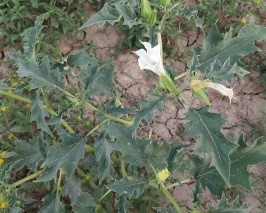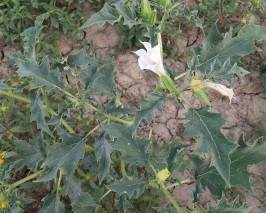Area
Akoln grows on habitats, roadsides, waterways, melons. It is found mainly in Ukraine, Belarus, Moldova, the southern and central regions of the European part of Russia, Crimea, the Caucasus, Central Asia, the Baltic states, and to a lesser extent in Western Siberia and the Far East. Grown in Ukraine and Krasnodar Krai. The product is mainly produced in Ukraine, Voronezh region and the North Caucasus.
Botanical description of the plant
Ordinary bangidevona -alfalfa - belongs to the family. An annual, odorless herbaceous plant, up to 100-120 cm tall. Stems erect, hairless, split branched The leaves are simple, ovoid, sharp-pointed, uneven deeply carved, banded, hairy green, hairless (poyaniig the upper ones are hairy) and are located in series on the stem. The flowers are large, arranged singly on the stem. The inflorescence is tubular, five-edged, five-toothed, the main part remains with the fruit in the form of a ring. Inflorescence white funnel-shaped, long and narrow tube, angularly carved, five-toothed, curved, twice as large as the inflorescence; paternity 5, maternal node two-chambered, upward. The fruit is an ovoid, hard and thick thorn-covered, erect-growing, four-stemmed corolla. The seeds are black, pale, round kidney-shaped, flat, with small pits on the upper side.
Bangidevona blooms from June to autumn, the fruits ripen from July. All parts of the plant are poisonous.

Medicinal properties
In all parts of the plant (leaf) 0.23-0.37%, up to 0.2% in the stem, up to 0.27% in the root, 0.22% in the seeds) alkaloids. The main alkaloids are giostiamine, atropine and scopolamine. Bangidevona leaf is part of the cigarettes "Astmatol" and "Astmatin" used in bronchial asthma.
Growing technology
It is advisable to plant Bangidevona in soils with sufficient moisture in the regions of Uzbekistan, especially in irrigated soils. It is not recommended to place Bangidevona in areas planted with plants such as tomatoes, potatoes, tobacco (family of alfalfa). Because the insects that infect these plants are the insects that infect bangidevona. Regardless of what past crops are planted in the soil of Bangidevona, in the autumn before plowing the soil should be fed with 20-25 tons of rotten manure per hectare, 70 kg of pure phosphorus fertilizer and plowed to a depth of 25-27 cm with a tractor. If Bangidevona is planted in early spring, the yield will be higher. Before sowing the seeds in early spring, level the soil with a harrow and rakes at a soil temperature of 15-17 ° C. The row spacing is 60 cm with vegetable seeders. in the soil it is planted at a depth of 3-4 cm. The seeds of the plant germinate in 15-22 days after sowing. The length of its growing season (until the grass sprouts and blooms) is up to 100 days. Since the young seedlings of Bangidevona are less resistant to weeds, it is necessary to intensify the inter-row cultivation as soon as possible, especially until the period of weeding the Bangidevona. When working between rows of the plant will need to use mechanisms very carefully so as not to bury the seedlings in the soil and debris. After the plant has produced 3-4 true leaves, 2 healthy seedlings are left in each nest at 60 cm intervals. Bangidevona will need to be continued depending on soil compaction during subsequent tillage and weed control. Later, when the plant reaches a height of 1 meter, when it is leafy, bangidevona squeezes the grass. The growth and development of the Bangidevona plant depends on the greater accumulation of biologically active substances in the raw material, the amount of organic and mineral fertilizers applied to it, depends on the agro-technical measures taken during the growing season. The first feeding should begin when the bangidevona produces 5–7 true leaves. The plant requires more nitrogen and phosphorus fertilizers. During this period, 30 kg of nitrogen and 20 kg of phosphorus are given per hectare. As a result of fertilization, the grass begins to grow rapidly. Given that the plant is demanding to fertilizers, the second fertilization should be carried out during the grazing period with the application of 30 kg of nitrogen and 20 kg of potassium fertilizers per hectare. Each fertilization is done before watering the plant. As a result of fertilization, the plant grows to 30-40 cm in height and the number of leaves increases. When Bangidevona blooms en masse, it is completed by applying 40 kg of nitrogen per hectare, 20 kg of phosphorus and potassium fertilizers. As a result of the measures taken, the leaves, which are its main raw material, develop very well. During the growing season it is recommended to feed the bangidevona plant with 100 kg of nitrogen, 70 kg of phosphorus and 50 kg of potassium fertilizers. During the season, it is recommended to irrigate bangidevona crops 8-9 times, taking into account air temperature and soil moisture. Once the bangidevona bears fruit, it will be possible to pick its leaves. First of all, the mature and blue leaves are collected without a tail. Then what is done and what is opened is dialed. It is not recommended to pick the leaves when it is raining and cold. Dry leaves can be harvested from the bangidevona plant by September 10-12, if timely treatment between feeding, watering and row spacing prevents pests. After the Bangidevona leaves are harvested 3 times, the plant is harvested with a silage harvester and taken out of the field and burned.





